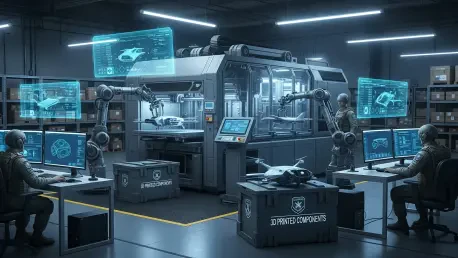In a groundbreaking stride for defense logistics, a collaboration between two UK-based innovators is reshaping how critical components are sourced and produced during supply chain crises. This partnership, involving a London-headquartered engineering giant and a Cambridge-based technology pioneer, is driving a flagship initiative under the UK Ministry of Defense (MOD). Known as Project TAMPA, this effort focuses on integrating additive manufacturing (AM) to ensure operational readiness even when traditional suppliers falter or parts become obsolete. By prioritizing secure, digital supply chains and distributed production, the initiative addresses urgent national resilience needs. The transformative potential of this approach lies in its ability to maintain defense capabilities under the most challenging circumstances, marking a significant shift in how military logistics can adapt to modern demands.
Advancing Defense Logistics Through Innovation
Transforming Supply Chains with Additive Manufacturing
The core of Project TAMPA lies in its ambition to revolutionize defense supply chains through the adoption of additive manufacturing techniques. This initiative, spearheaded by a prominent London-based engineering firm, focuses on utilizing Laser Beam Powder Bed Fusion (PBF-LB) to produce critical components across multiple suppliers. The challenge of ensuring consistent quality and certification across varied production environments is being tackled head-on, demonstrating that distributed manufacturing can meet stringent defense standards. By leveraging digital designs, the project enables rapid production of parts wherever they are needed, reducing dependency on single suppliers and mitigating risks associated with supply chain disruptions. This approach not only enhances flexibility but also ensures that the MOD can maintain operational continuity, even in the face of unforeseen challenges like obsolescence or geopolitical constraints.
A deeper look into this transformative effort reveals the strategic importance of coordination and standardization. The engineering firm at the helm plays a pivotal role in orchestrating the production process, ensuring that every component meets approved specifications regardless of where it is manufactured. This meticulous oversight is crucial for building trust in distributed manufacturing models, particularly in defense applications where reliability is non-negotiable. The ability to produce parts on-demand through AM also addresses long-standing issues of inventory management, cutting down on storage costs and waste. Furthermore, this method supports the rapid deployment of solutions in crisis situations, providing a tactical advantage by minimizing downtime for essential equipment. The implications of such advancements extend beyond immediate needs, setting a foundation for future scalability in defense logistics.
Pioneering Testing Solutions for Material Validation
Equally significant is the contribution of cutting-edge testing technology from a Cambridge-based innovator, which introduces a novel method to validate the mechanical properties of AM-produced parts. Known as Profilometry-based Indentation Plastometry (PIP), this technique uses the PLX-Benchtop system to derive stress-strain curves through an inverse finite element approach. Unlike traditional tensile testing, PIP is faster, more cost-effective, and minimally destructive, allowing evaluations on small samples or directly on components. This capability is vital for detecting variations in material properties within and between builds, a common challenge in AM. By offering a reliable alternative to conventional methods, PIP ensures that parts meet performance standards without the delays associated with extensive testing processes.
The impact of PIP technology on defense manufacturing cannot be overstated, as it directly addresses the need for speed and precision in validating critical components. This innovative approach enables rapid assessments, ensuring that any discrepancies in material behavior are identified and resolved swiftly. Such efficiency is particularly crucial in high-stakes environments where delays can compromise mission readiness. Additionally, the non-destructive nature of PIP reduces material waste and lowers costs, aligning with broader goals of sustainability and resource optimization. The integration of this technology into Project TAMPA exemplifies how advanced solutions can bridge gaps in traditional manufacturing, providing confidence in the performance of AM-produced parts. As a result, the MOD gains a strategic tool to maintain supply chain integrity under pressure.
Building Resilience for Future Challenges
Strengthening National Defense Capabilities
Project TAMPA represents a forward-thinking strategy to bolster national defense by ensuring access to critical components during emergencies. The collaboration between the two UK firms underscores a shared commitment to innovation, with efforts focused on mitigating risks such as supplier unavailability or part obsolescence. By establishing a secure digital supply chain, the initiative allows for distributed production that can adapt to changing circumstances. Complex parts across various platforms are being prioritized in this endeavor, with work already underway to address immediate needs. The ability to produce certifiable components quickly and reliably enhances the MOD’s capacity to respond to evolving threats, reinforcing the importance of adaptability in modern defense logistics.
Beyond immediate applications, this partnership sets a precedent for long-term advancements in military manufacturing. The emphasis on digital and distributed solutions highlights a shift away from rigid, centralized production models toward more agile frameworks. This transition not only improves material availability but also reduces reliance on slow, destructive testing methods that have long hindered progress. Insights from industry leaders involved in the project emphasize the role of innovation in overcoming these limitations, pointing to a future where defense supply chains are both resilient and responsive. The strategic focus on complex components ensures that even the most challenging requirements can be met, paving the way for broader adoption of AM technologies across defense sectors.
Reflecting on Collaborative Achievements
Looking back, the alliance between the London engineering leader and the Cambridge technology expert proved instrumental in pushing the boundaries of defense manufacturing. Their combined efforts under Project TAMPA tackled pressing supply chain challenges with remarkable ingenuity, integrating advanced AM processes and non-destructive testing methods like PIP. The successful coordination of distributed production and the validation of part performance stood as testaments to what collaborative innovation could achieve. By focusing on operational readiness, this partnership delivered tangible improvements in how critical components were sourced and certified, ensuring that defense capabilities remained robust even under strain.
The legacy of this collaboration lies in the actionable pathways it created for future progress. Moving forward, the emphasis should be on scaling these solutions to encompass a wider range of defense applications while continuing to refine technologies like PIP for greater precision. Exploring additional partnerships and investing in digital infrastructure will be key to sustaining momentum. Moreover, sharing lessons learned from this initiative with other sectors could amplify its impact, fostering resilience across industries. As the MOD builds on these foundations, the focus must remain on adaptability and innovation to address emerging challenges in an ever-changing global landscape.









